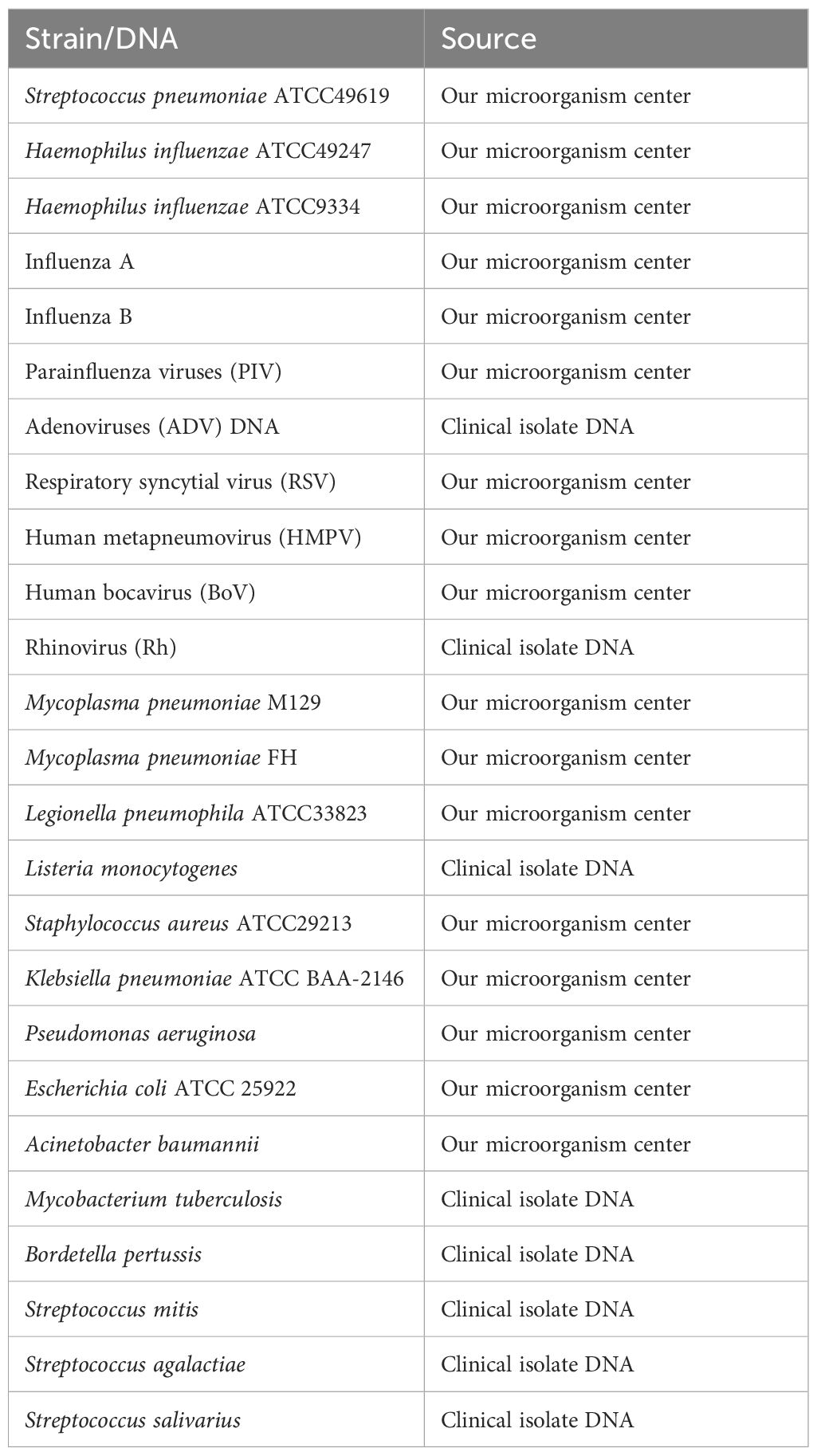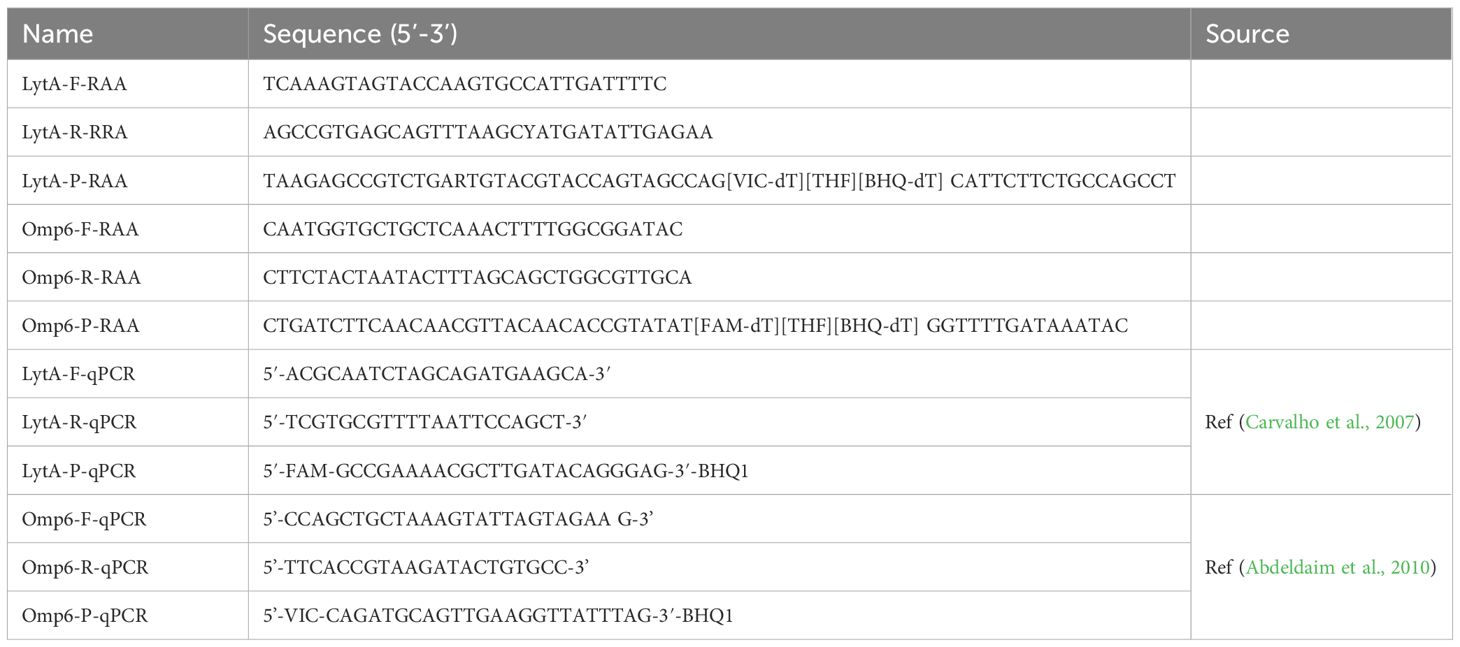- Capital Center for Children’s Health, Capital Medical University, Capital Institute of Pediatrics, Beijing, China
Introduction: Community-acquired pneumonia (CAP) remains a leading cause of mortality in children under five years of age worldwide. Streptococcus pneumoniae and Haemophilus influenzae are the most common bacterial pathogens causing CAP that requires hospitalization, highlighting the critical need for a simple, low-cost, and highly sensitive method for rapid diagnosis.
Methods: We developed a duplex recombinase-aided amplification (RAA) assay for the simultaneous detection of S. pneumoniae and H. influenzae. Following comparative genomic analysis, the conserved lytA gene and omp6 gene were selected as the specific targets for S. pneumoniae and H. influenzae, respectively. The reaction conditions, including temperature and probe concentration, were optimized.
Results: The established duplex RAA assay can be completed within 10 minutes at a constant temperature of 39°C, with an optimal probe concentration combination of 0.6 μM for S. pneumoniae and 0.8 μM for H. influenzae. The assay demonstrated high sensitivity, with a limit of detection of 72 copies per reaction for S. pneumoniae and 35 copies per reaction for H. influenzae.
Discussion: This study presents a rapid and accurate nucleic acid amplification assay for the concurrent detection of two major bacterial pathogens in childhood CAP. The speed, simplicity, and sensitivity of the duplex RAA assay make it a promising tool for early and rapid etiological diagnosis in clinical settings.
Introduction
Community-acquired pneumonia (CAP) is one of the most common and serious infections in children worldwide, potentially leading to severe complications such as sepsis, acute respiratory distress syndrome, or death (Vaughn et al., 2024). The etiological spectrum of CAP is broad, encompassing a variety of bacteria and viruses (Liu et al., 2023). Among bacterial pathogens, Haemophilus influenzae and Streptococcus pneumoniae are the two most frequently implicated species. Furthermore, these two pathogens, along with Neisseria meningitidis, are leading causes of invasive diseases, including bacteremia, pneumonia, and meningitis. They are also common agents of secondary infections following viral respiratory disease and frequent co-pathogens with Mycoplasma pneumoniae (Brueggemann et al., 2021).
H. influenzae is a Gram-negative, non-motile bacterium first isolated from the nasopharynx of patients during an influenza epidemic (Wen et al., 2020). S. pneumoniae is a Gram-positive, encapsulated diplococcus pathogen first identified from the sputum of a pneumonia patient in 1881 (Zivich et al., 2018). Both organisms are transmitted via respiratory droplets from infected or colonized individuals and subsequently colonize the mucosal surfaces of the nasopharynx and upper airway. This colonization can lead to a range of infections, including otitis media, epiglottitis, sinusitis, pneumonia, meningitis, and bacteremia (Revai et al., 2008). The identification of S. pneumoniae and H. influenzae is also critical for guiding appropriate antibiotic therapy. A recent study demonstrated that antibiotics were of little benefit for children with acute sinusitis if these bacterial pathogens were absent in the nasopharynx, suggesting that accurate testing for these two bacteria could help reduce unnecessary antibiotic use (Shaikh et al., 2023). Given the clinical significance of these pathogens, the development of accurate and rapid molecular detection methods is crucial for timely diagnosis and treatment.
Despite being the traditional gold standard for diagnosis, bacterial culture often yields a lower positive rate for these two fastidious organisms compared to other pathogens, which is a major constraint in many clinical laboratories (Farajzadeh Sheikh et al., 2021; Sharma et al., 2021). Recombinase-aided amplification (RAA) assay is an isothermal amplification technology known for its high specificity, sensitivity, and portability. The RAA system is composed of three key proteins: a recombinase (which anneals primers to the template DNA), a single-strand DNA binding protein (SSB), and a DNA polymerase (for amplification and extension). The coordinated action of these components with specific primers and fluorescent probes enables a rapid and specific reaction, making the technology highly suitable for point-of-care testing (POCT) and the detection of fastidious bacteria. Recently, RAA has been successfully used to detect various microbial pathogens, such as Mycoplasma pneumoniae, Monkeypox virus, and Candida auris (Xue et al., 2020; Cui et al., 2023; Feng et al., 2024).
In this study, we developed a duplex RAA assay for the simultaneous detection of S. pneumoniae and H. influenzae in a single tube. We then validated the application of this method using invasive clinical samples and compared its performance against bacterial culture and a previously published real-time PCR method.
Materials and methods
Ethics statement and clinical specimen collection
This study was approved by the Ethics Committee of the Capital Institute of Pediatrics. Written informed consent was obtained from the legal guardian of each pediatric patient prior to sample collection.
A total of 168 specimens were collected from pediatric patients at the Capital Center for Children’s Health, Capital Medical University, Capital Institute of Pediatrics, Beijing, China, between January 2023 and December 2024. Each specimen was obtained from a unique patient, and the collection comprised 160 bronchoalveolar lavage fluid (BALF) samples and 8 cerebrospinal fluid (CSF) samples.
Bacterial and viral strains/DNA
Standard reference strains of H. influenzae (non-encapsulated, ATCC 49247; and encapsulated, ATCC 9334) and S. pneumoniae (ATCC 49619) were used to establish and validate the assay. To evaluate analytical specificity, a panel of nucleic acids from common respiratory pathogens stored at the Capital Institute of Pediatrics was tested. This panel included: Mycoplasma pneumoniae, Staphylococcus aureus, Klebsiella pneumoniae, Pseudomonas aeruginosa, Escherichia coli, Legionella pneumophila, Listeria monocytogenes, Acinetobacter baumannii, Mycobacterium tuberculosis, Bordetella pertussis, Streptococcus mitis, Streptococcus oralis, Streptococcus agalactiae, Streptococcus mutans, Streptococcus parasanguinis, Streptococcus sanguinis, Streptococcus salivarius, influenza A and B viruses, parainfluenza viruses, adenoviruses, respiratory syncytial virus, human metapneumovirus, human bocavirus, and rhinovirus (Table 1).
DNA extraction
Total genomic DNA was extracted from bacterial cultures and clinical specimens using the QIAamp DNA Mini Kit (Qiagen, Hilden, Germany) according to the manufacturer’s instructions. The extracted DNA was eluted in 150 μL of nuclease-free water and stored at −80°C until further use. DNA concentrations were measured using a NanoDrop spectrophotometer (Thermo Fisher Scientific, USA). DNA copy numbers were calculated using the following formula: DNA copy number (copies/μL) = [6.02 × 1023 × plasmid concentration (ng/μL) × 10−9]/[DNA length (in nucleotides) × 660].
Primer and probe design
Conserved regions within the lytA gene of S. pneumoniae and the omp6 gene of H. influenzae were selected as amplification targets. Specific primers and probes were designed following the principles of the recombinase-aided amplification (RAA) assay. The specificity of all primers and probes was confirmed in silico using NCBI’s Primer-BLAST tool. Potential secondary structures, such as primer-dimers and hairpins, were analyzed using the online OligoEvaluator software. All oligonucleotides were synthesized and purified via high-performance liquid chromatography by Sangon Biotech (Shanghai, China).
Recombinant plasmid construction
The full-length sequences of the lytA and omp6 genes were PCR-amplified and subsequently cloned into the pUC57 vector (Tiangen Biotech Co., Ltd., Beijing, China). These recombinant plasmids served as standards. Tenfold serial dilutions were prepared to create standards with concentrations ranging from 107 to 100 copies/μL, which were then stored at −80°C.
Duplex RAA assay procedure
RAA assays were conducted in a total reaction volume of 50 μL using a commercial RAA kit (Jiangsu Qitian Bio-Tech Co., Ltd., China). Each reaction mixture contained 2 µL of template DNA, 25 µL of reaction buffer, 15.7 µL of DNase-free water, 2.5 µL of 280 mM magnesium acetate, 2.1 µL of each lytA primer (10 µM), 2.1 µL of each omp6 primer (10 µM), and a combination of lytA (VIC-labeled) and omp6 (FAM-labeled) probes. Probe concentrations were optimized by testing various combinations (0.6/0.8 µM, 0.6/0.6 µM, and 0.8/0.6 µM). The mixture was added to a tube containing the lyophilized RAA enzyme pellet. The tubes were vortexed and centrifuged, then incubated in a B6100 Oscillation Mixer for 4 min. Finally, the tubes were transferred to a real-time fluorescence detector (QT-RAA-1620) for signal acquisition at 39°C for 20 min.
Analysis of sensitivity and specificity
The analytical sensitivity of the RAA assay was determined using tenfold serial dilutions of the recombinant plasmid ranging from 107 to 100 copies/μL. The analytical specificity was evaluated by testing the RAA assay against the panel of non-target microbial pathogens listed in Table 1. Standard S. pneumoniae and H. influenzae DNA were used as positive controls, and nuclease-free water served as the negative control.
Clinical specimen evaluation
All 168 clinical specimens were tested in parallel using the newly developed duplex RAA assay, the previously published real-time PCR assays for S. pneumoniae (Carvalho et al., 2007) and H. influenzae (Abdeldaim et al., 2010), and conventional bacterial culture. The primers and probes used for real-time PCR are listed in Table 2. PCR cycling conditions were performed as described in the respective publications (Carvalho et al., 2007; Abdeldaim et al., 2010).
Statistical analysis
Statistical analyses were performed using SPSS version 21.0. The diagnostic performance of the duplex RAA assay, including its sensitivity, specificity, positive predictive value (PPV), and negative predictive value (NPV), was evaluated by the chi-square test using real-time PCR as the gold standard. Based on the confusion matrix, samples were classified as true positive (TP), false positive (FP), true negative (TN), or false negative (FN). The detailed metrics were calculated as follows: Sensitivity = TP/(TP + FN); Specificity = TN/(TN + FP); PPV = TP/(TP + FP); NPV = TN/(TN + FN).
Results
Establishment and workflow of the duplex RAA method
The workflow for the duplex recombinase-aided amplification (RAA) assay was streamlined for rapid sample-to-result analysis. Following DNA extraction from clinical specimens, the prepared reaction mixture—containing primers and probes for both S. pneumoniae (VIC channel) and H. influenzae (FAM channel)—was incubated in an isothermal instrument. Positive results were typically observed within 10 min, with a total turnaround time of under 20 min (Figure 1A).
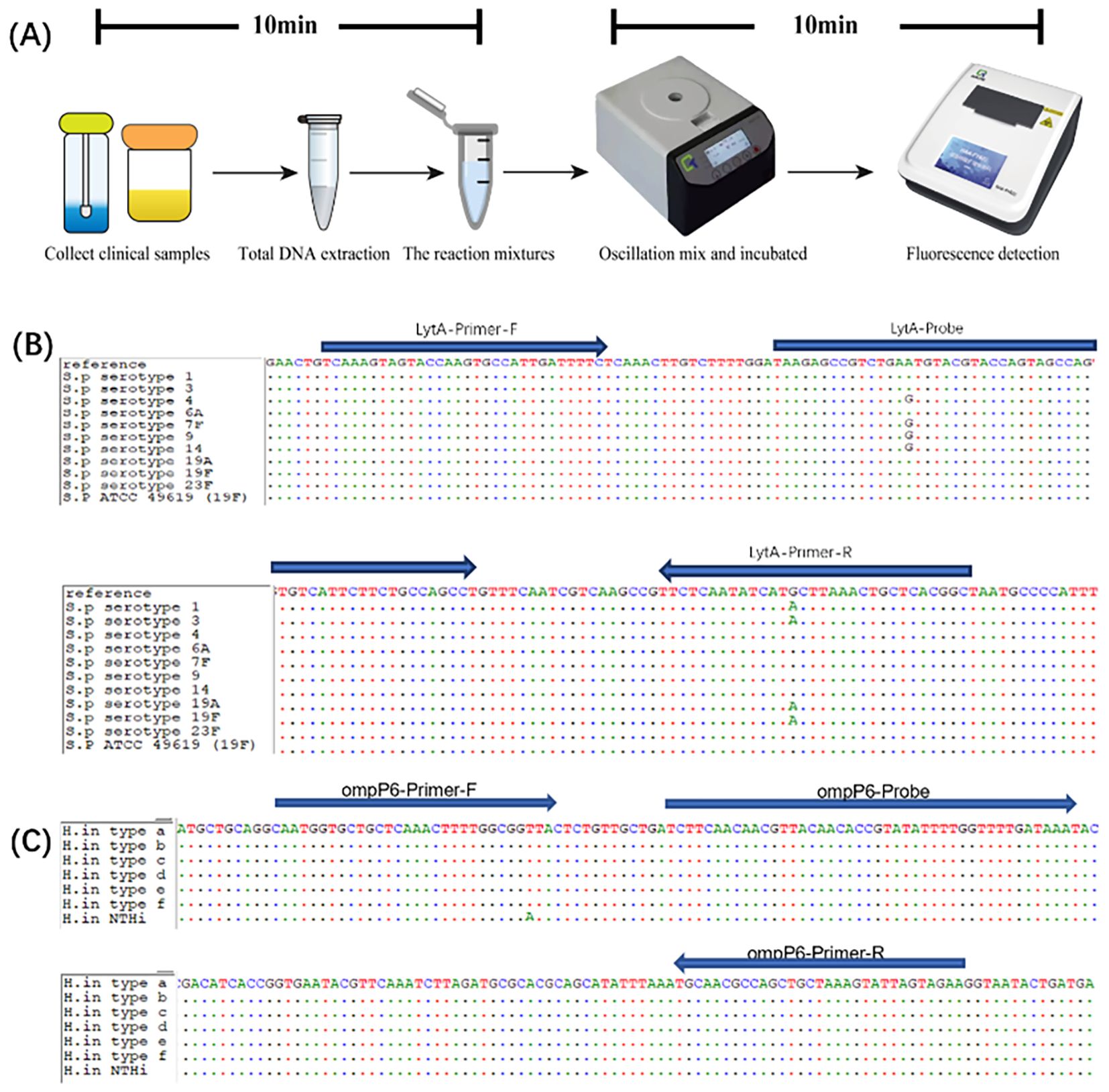
Figure 1. Establishment of the duplex recombinase-aided amplification (RAA) method. (A) Workflow of the duplex RAA method. (B) Alignment of the lytA gene among different S. pneumoniae strains, including serotype 1, type 3, type 4, type 6A, type 7F, type 9C, type 14, type 19A, type 19F, and type 23F. (C) Alignment of the omp6 gene among different H influenzae strains, including typeable (encapsulated a–f) and nontypeable (nonencapsulated) strains.
To ensure comprehensive detection across diverse strains—including typeable (a-f) and non-typeable H. influenzae (Bakaletz and Novotny, 2018) and the numerous serogroups of S. pneumoniae (Davies et al., 2022)—we selected highly conserved target regions. Through comparative genomic analysis, the omp6 gene of H. influenzae and the lytA gene of S. pneumoniae were chosen. Specific primers and probes were designed within these conserved regions, with certain single-nucleotide polymorphism (SNP) loci among different types accounted for by introducing degenerate bases (Figures 1B, C). The potential for primer-dimer and hairpin formation was assessed using online tools from Integrated DNA Technologies (IDT), and no significant secondary structures were predicted.
Optimization of the duplex RAA reaction system
To achieve optimal amplification efficiency, we systematically tested different probe concentrations and reaction temperatures. Various combinations of the lytA (S. pneumoniae) and omp6 (H. influenzae) probes were evaluated. A final concentration of 0.8 μM for the lytA probe and 0.6 μM for the omp6 probe yielded the most robust and consistent amplification signals. Subsequently, this optimal probe combination was tested at 37°C, 39°C, and 42°C. The reaction performed at 39°C produced the highest fluorescence intensity (Figure 2). Consequently, these optimal conditions (0.8/0.6 μM probes at 39°C) were used for all subsequent experiments.
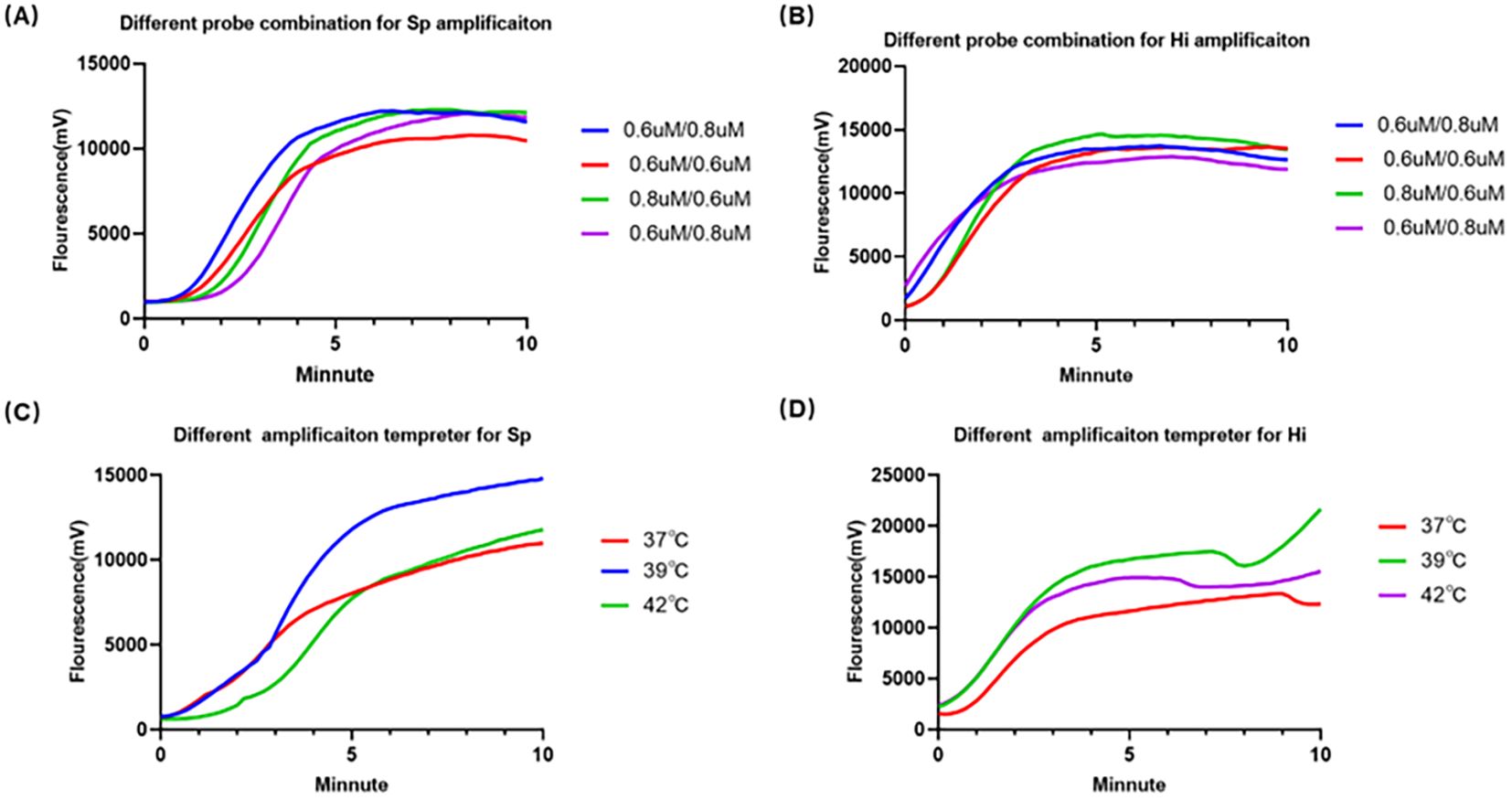
Figure 2. Optimization of the duplex RAA assay parameters. (A) Relative fluorescence curves for different RAA probe combinations for S. pneumoniae. (B) Relative fluorescence curves for different RAA probe combinations for H influenzae. (C) Relative fluorescence curves at different incubation temperatures (37°C, 39 °C,42°C for S. pneumoniae. (D) Relative fluorescence curves at different incubation temperatures (37°C, 39 °C,42°C for H influenzae.
Analytical specificity and sensitivity
The analytical specificity of the duplex RAA assay was confirmed using a panel of common respiratory pathogens. As shown in Figure 3, amplification signals were generated exclusively from S. pneumoniae and H. influenzae templates. No cross-reactivity was observed with any of the other bacterial or viral nucleic acids tested, nor in the no-template (water) control, demonstrating 100% specificity.
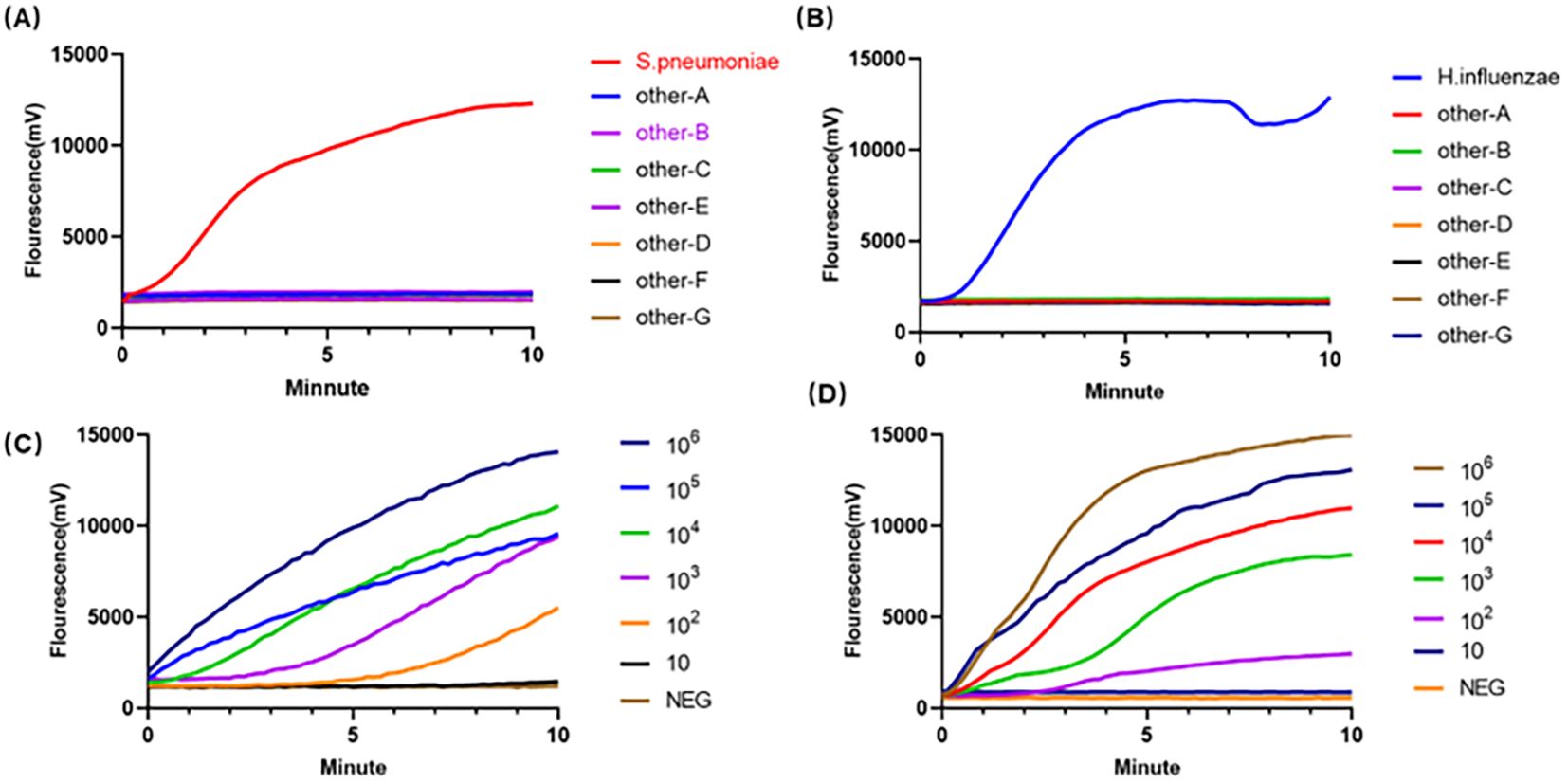
Figure 3. Specificity and sensitivity of the duplex RAA assay for S. pneumoniae and H influenzae detection. (A) Specificity of the RAA assay for S. pneumoniae. (B) Specificity of the RAA assay for H influenzae. (C) Sensitivity of the RAA assay for S. pneumoniae. (D) Sensitivity of the RAA assay for H influenzae.
The analytical sensitivity was determined using tenfold serial dilutions of recombinant plasmids containing the target genes. A clear fluorescence signal was detected across dilutions ranging from 1 × 107 down to 1 × 10¹ copies/reaction. The limit of detection (LOD) was established as 72 copies/reaction for S. pneumoniae and 35 copies/reaction for H. influenzae.
Evaluation of the duplex RAA assay on clinical samples
The clinical performance of the duplex RAA assay was evaluated using 168 invasive specimens, with results compared against those from a validated real-time PCR assay and conventional bacterial culture. The RAA assay identified 18 specimens as positive for S. pneumoniae and 21 for H. influenzae. Among these, six specimens were positive for both pathogens. When real-time PCR was used as the diagnostic gold standard, the duplex RAA assay for the two pathogens showed 100% positive predictive value (PPV) and negative predictive value (NPV). In contrast, bacterial culture yielded significantly fewer positive results, detecting only nine cases of S. pneumoniae and seven cases of H. influenzae (Table 3).

Table 3. Comparison of RAA assay, real-time PCR and culture for S.pneumoniae and H. influenzae detection of clinical samples.
Discussion
Streptococcus pneumoniae and Haemophilus influenzae are common inhabitants of the human nasopharyngeal microflora but can migrate to sterile sites to cause invasive disease (Eichner et al., 2021). Recent metagenomic studies of BALF from children have identified S. pneumoniae and H. influenzae as dominant pathogens (Yang et al., 2022). Similarly, advanced sequencing of cerebrospinal fluid in resource-limited settings has shown S. pneumoniae to be a primary cause of bacterial meningitis (Pallerla et al., 2022). Given the clinical importance of these bacteria, a rapid and accurate detection method applicable directly to clinical samples is essential for early diagnosis. Any diagnostic delay can increase mortality, prolong hospital stays, and elevate healthcare expenditures (Pallerla et al., 2022).
Since both pathogens can asymptomatically colonize the nasopharynx, a positive result from noninvasive samples (e.g., pharyngeal swabs) can make it difficult to distinguish between pathogenic infection and carriage. To address this diagnostic ambiguity, our study focused on developing a duplex recombinase-aided amplification (RAA) assay and evaluating it on invasive clinical samples (BALF and CSF). This approach provides a more conclusive diagnostic basis for clinicians. The RAA assay achieves amplification in approximately 10 min, significantly reducing the turnaround time compared with real-time PCR and enhancing its utility in clinical settings.
For developing robust diagnostic methods, selecting highly conserved target sequences is crucial to ensure comprehensive detection across numerous serotypes. Given the genomic variability among different genotypes and serotypes of these pathogens, this initial step is critical for accuracy. Previous research on S. pneumoniae has utilized various gene targets, including those encoding pneumolysin (ply), autolysin (lytA), Spn9802, capsular polysaccharide biosynthesis proteins (cps), and pneumococcal surface antigen A (psaA) (Blaschke, 2011; Wessels et al., 2012; Chang et al., 2021). Notably, the lytA gene, which encodes a cell wall hydrolase, is a recognized virulence factor due to its role in releasing highly inflammatory cell wall components and pneumolysin. Consequently, it has been repeatedly validated as an effective and reliable detection target (Seki et al., 2005). For H. influenzae, specific genes such as the outer membrane protein P6 gene (omp6) and 16S rRNA have been successfully targeted (Maleki et al., 2020; Wang et al., 2022). For instance, Cao et al. established an isothermal amplification technology based on the omp6 gene, achieving sensitive detection by coupling multiple cross displacement amplification with a nanoparticle-based lateral flow biosensor (Cao et al., 2021).
Informed by these previous studies, we selected the lytA and omp6 genes as target markers for our assay. Sequence alignments confirmed that these genes exhibit high sequence homology across diverse serotypes. Consequently, primers and probes were designed based on these conserved regions. The resulting single-tube duplex assay demonstrated high specificity for various strains of H. influenzae and S. pneumoniae, with no cross-reactivity observed against other common respiratory pathogens. The analytical sensitivity was determined to be 72 copies per reaction for S. pneumoniae (lytA) and 35 copies per reaction for H. influenzae (omp6). This performance is comparable to the sensitivity of previously reported real-time PCR assays, which typically ranges from 10 to 100 copies per reaction (Abdeldaim et al., 2009; Meyler et al., 2012; Hajia et al., 2014), indicating that our RAA assay exhibits competitive detection sensitivity.
To evaluate the clinical utility of this method, we analyzed 168 invasive clinical samples. The results from both the RAA and real-time PCR assays demonstrated 100% concordance, with positive detection rates of 10.71% for S. pneumoniae and 12.5% for H. influenzae. In contrast, the positive rates for bacterial culture were only 5.36% and 4.17%, respectively. Notably, for samples that were culture-negative but RAA-positive, the amplification dynamics suggested a low bacterial load, likely below the detection threshold of conventional culture. This finding highlights the superior sensitivity of the RAA assay. Furthermore, we observed a high rate of co-infection: 33.3% (6/18) of the S. pneumoniae-positive samples were also co-infected with H. influenzae. As previous studies have indicated, co-infection with these two pathogens can exacerbate pneumonia and increase mortality in pediatric patients (Pneumonia Etiology Research for Child Health (PERCH) Study Group, 2019). These findings underscore the clinical importance of simultaneous detection.
However, this study has limitations. The primary limitation is the qualitative nature of the RAA assay. Although the amplification curve can provide a semi-quantitative indication of bacterial load, it does not offer the precise quantification achievable with methods such as real-time PCR.
In summary, we have developed a duplex RAA assay for the simultaneous detection of H. influenzae and S. pneumoniae in clinical samples, demonstrating high specificity and sensitivity. This assay offers significant advantages, including simplified reaction conditions, a reduced turnaround time, and lower cost compared with traditional culture methods and real-time PCR. Therefore, it holds substantial potential for clinical application, particularly for the rapid analysis of invasive specimens.
Data availability statement
Publicly available datasets were analyzed in this study. This data can be found here: https://www.ncbi.nlm.nih.gov/.
Ethics statement
The studies involving humans were approved by the Ethics Committee of Capital Institute of Pediatrics. The studies were conducted in accordance with the local legislation and institutional requirements. Written informed consent for participation in this study was provided by the participants’ legal guardians/next of kin.
Author contributions
LZ: Writing – original draft, Writing – review & editing. YX: Writing – original draft, Writing – review & editing. YF: Writing – original draft, Writing – review & editing. BD: Writing – original draft. XH: Formal Analysis, Writing – original draft. WX: Writing – original draft. JL: Writing – original draft. FF: Writing – original draft. CM: Writing – original draft. LY: Writing – original draft. LM: Writing – original draft, Writing – review & editing. GX: Writing – original draft, Writing – review & editing. JY: Writing – original draft, Writing – review & editing.
Funding
The author(s) declare financial support was received for the research and/or publication of this article. This work was supported by grants from the Beijing Research Ward Excellence Program (BRWEP2024W102100100), the National Natural Science Foundation of China (32170201, 82130065), Beijing Natural Science Foundation (7242015, 7232007, L232071), FENG foundation (FFBR 202103). Beijing High-Level Public Health Technical Talent Project (2023-02-08), Beijing Hospitals Authority’s Ascent Plan (DFL20241301), Beijing Municipal Public Welfare Development and Reform Pilot Project for Medical Research Institutes (JYY2023-10).
Conflict of interest
The authors declare that the research was conducted in the absence of any commercial or financial relationships that could be construed as a potential conflict of interest.
The reviewer LS declared a shared parent affiliation with the authors to the handling editor at the time of review.
Generative AI statement
The author(s) declare that no Generative AI was used in the creation of this manuscript.
Any alternative text (alt text) provided alongside figures in this article has been generated by Frontiers with the support of artificial intelligence and reasonable efforts have been made to ensure accuracy, including review by the authors wherever possible. If you identify any issues, please contact us.
Publisher’s note
All claims expressed in this article are solely those of the authors and do not necessarily represent those of their affiliated organizations, or those of the publisher, the editors and the reviewers. Any product that may be evaluated in this article, or claim that may be made by its manufacturer, is not guaranteed or endorsed by the publisher.
References
Abdeldaim, G. M. K., Strålin, K., Kirsebom, L. A., Olcén, P., Blomberg, J., and Herrmann, B. (2009). Detection of Haemophilus influenzae in respiratory secretions from pneumonia patients by quantitative real-time polymerase chain reaction. Diagn. Microbiol. Infect. Dis. 64, 366–373. doi: 10.1016/j.diagmicrobio.2009.03.030
Abdeldaim, G. M. K., Strålin, K., Korsgaard, J., Blomberg, J., Welinder-Olsson, C., and Herrmann, B. (2010). Multiplex quantitative PCR for detection of lower respiratory tract infection and meningitis caused by Streptococcus pneumoniae, Haemophilus influenzae and Neisseria meningitidis. BMC Microbiol. 10, 310. doi: 10.1186/1471-2180-10-310
Bakaletz, L. O. and Novotny, L. A. (2018). Nontypeable haemophilus influenzae (NTHi). Trends Microbiol. 26, 727–728. doi: 10.1016/j.tim.2018.05.001
Blaschke, A. J. (2011). Interpreting assays for the detection of Streptococcus pneumoniae. Clin. Infect. Dis. 52 Suppl 4, S331–S337. doi: 10.1093/cid/cir048
Brueggemann, A. B., Jansen van Rensburg, M. J., Shaw, D., McCarthy, N. D., Jolley, K. A., Maiden, M. C. J., et al. (2021). Changes in the incidence of invasive disease due to Streptococcus pneumoniae, Haemophilus influenzae, and Neisseria meningitidis during the COVID-19 pandemic in 26 countries and territories in the Invasive Respiratory Infection Surveillance Initiative: a prospective analysis of surveillance data. Lancet Digital Health 3, e360–e370. doi: 10.1016/S2589-7500(21)00077-7
Cao, Q., Liang, S., Wang, L., Cao, J., Liu, M., Li, S., et al. (2021). A rapid detection of haemophilus influenzae using multiple cross displacement amplification linked with nanoparticle-based lateral flow biosensor. Front. Cell Infect. Microbiol. 11. doi: 10.3389/fcimb.2021.721547
Carvalho, M., da, G. S., Tondella, M. L., McCaustland, K., Weidlich, L., McGee, L., et al. (2007). Evaluation and improvement of real-time PCR assays targeting lytA, ply, and psaA genes for detection of pneumococcal DNA. J. Clin. Microbiol. 45, 2460–2466. doi: 10.1128/JCM.02498-06
Chang, B., Kinjo, Y., Morita, M., Tamura, K., Watanabe, H., Tanabe, Y., et al. (2021). Distribution and variation of serotypes and pneumococcal surface protein A clades of streptococcus pneumoniae strains isolated from adult patients with invasive pneumococcal disease in Japan. Front. Cell Infect. Microbiol. 11. doi: 10.3389/fcimb.2021.617573
Cui, X., Du, B., Feng, J., Feng, Y., Cui, J., Yan, C., et al. (2023). Rapid detection of mpox virus using recombinase aided amplification assay. Front. Cell Infect. Microbiol. 13. doi: 10.3389/fcimb.2023.1008783
Davies, L. R. L., Cizmeci, D., Guo, W., Luedemann, C., Alexander-Parrish, R., Grant, L., et al. (2022). Polysaccharide and conjugate vaccines to Streptococcus pneumoniae generate distinct humoral responses. Sci. Transl. Med. 14, eabm4065. doi: 10.1126/scitranslmed.abm4065
Eichner, H., Karlsson, J., Spelmink, L., Pathak, A., Sham, L.-T., Henriques-Normark, B., et al. (2021). RNA thermosensors facilitate Streptococcus pneumoniae and Haemophilus influenzae immune evasion. PloS Pathog. 17, e1009513. doi: 10.1371/journal.ppat.1009513
Farajzadeh Sheikh, A., Rahimi, R., Meghdadi, H., Alami, A., and Saki, M. (2021). Multiplex polymerase chain reaction detection of Streptococcus pneumoniae and Haemophilus influenzae and their antibiotic resistance in patients with community-acquired pneumonia from southwest Iran. BMC Microbiol. 21, 343. doi: 10.1186/s12866-021-02408-7
Feng, J., Chen, J., Du, B., Cui, X., Xia, Y., Xue, G., et al. (2024). Development of a recombinase-aided amplification assay for the rapid detection of candida auris. Anal. Chem. 96, 9424–9429. doi: 10.1021/acs.analchem.4c00450
Hajia, M., Farzanehkhah, M., Hajihashemi, B., Dolatyar, A., Imani, M., Saburian, R., et al. (2014). Real-time assay as a tool for detecting lytA gene in Streptococcus pneumoniae isolates. Cell J. 16 (2), 141–146.
Liu, Y.-N., Zhang, Y.-F., Xu, Q., Qiu, Y., Lu, Q.-B., Wang, T., et al. (2023). Infection and co-infection patterns of community-acquired pneumonia in patients of different ages in China from 2009 to 2020: a national surveillance study. Lancet Microbe 4, e330–e339. doi: 10.1016/S2666-5247(23)00031-9
Maleki, A., Mansournia, F., Ghafourian, S., Taherikalani, M., Pakzad, I., Mohammadi, J., et al. (2020). Rapid and direct molecular detection of Streptococcus pneumoniae and Haemophilus influenzae isolated in oropharynx and nasal cavity of children. New Microbes New Infect. 33, 100632. doi: 10.1016/j.nmni.2019.100632
Meyler, K. L., Meehan, M., Bennett, D., Cunney, R., and Cafferkey, M. (2012). Development of a diagnostic real-time polymerase chain reaction assay for the detection of invasive Haemophilus influenzae in clinical samples. Diagn. Microbiol. Infect. Dis. 74, 356–362. doi: 10.1016/j.diagmicrobio.2012.08.018
Pallerla, S. R., Van Dong, D., Linh, L. T. K., Van Son, T., Quyen, D. T., Hoan, P. Q., et al. (2022). Diagnosis of pathogens causing bacterial meningitis using Nanopore sequencing in a resource-limited setting. Ann. Clin. Microbiol. Antimicrob. 21, 39. doi: 10.1186/s12941-022-00530-6
Pneumonia Etiology Research for Child Health (PERCH) Study Group (2019). Causes of severe pneumonia requiring hospital admission in children without HIV infection from Africa and Asia: the PERCH multi-country case-control study. Lancet 394, 757–779. doi: 10.1016/S0140-6736(19)30721-4
Revai, K., Mamidi, D., and Chonmaitree, T. (2008). Association of nasopharyngeal bacterial colonization during upper respiratory tract infection and the development of acute otitis media. Clin. Infect. Dis. 46, e34–e37. doi: 10.1086/525856
Seki, M., Yamashita, Y., Torigoe, H., Tsuda, H., Sato, S., and Maeno, M. (2005). Loop-mediated isothermal amplification method targeting the lytA gene for detection of Streptococcus pneumoniae. J. Clin. Microbiol. 43, 1581–1586. doi: 10.1128/JCM.43.4.1581-1586.2005
Shaikh, N., Hoberman, A., Shope, T. R., Jeong, J.-H., Kurs-Lasky, M., Martin, J. M., et al. (2023). Identifying children likely to benefit from antibiotics for acute sinusitis: A randomized clinical trial. JAMA 330, 349–358. doi: 10.1001/jama.2023.10854
Sharma, S., Acharya, J., Caugant, D. A., Banjara, M. R., Ghimire, P., and Singh, A. (2021). Detection of Streptococcus pneumoniae, Neisseria meningitidis and Haemophilus influenzae in Culture Negative Cerebrospinal Fluid Samples from Meningitis Patients Using a Multiplex Polymerase Chain Reaction in Nepal. Infect. Dis. Rep. 13, 173–180. doi: 10.3390/idr13010019
Vaughn, V. M., Dickson, R. P., Horowitz, J. K., and Flanders, S. A. (2024). Community-acquired pneumonia: A review. JAMA 332, 1282–1295. doi: 10.1001/jama.2024.14796
Wang, Y., Liu, A., Fu, M., Guo, J., Wang, L., Zuo, X., et al. (2022). Establishment and clinical application of a RPA-LFS assay for detection of capsulated and non-capsulated haemophilus influenzae. Front. Cell Infect. Microbiol. 12. doi: 10.3389/fcimb.2022.878813
Wen, S., Feng, D., Chen, D., Yang, L., and Xu, Z. (2020). Molecular epidemiology and evolution of Haemophilus influenzae. Infection Genet. Evol. 80, 104205. doi: 10.1016/j.meegid.2020.104205
Wessels, E., Schelfaut, J. J. G., Bernards, A. T., and Claas, E. C. J. (2012). Evaluation of several biochemical and molecular techniques for identification of Streptococcus pneumoniae and Streptococcus pseudopneumoniae and their detection in respiratory samples. J. Clin. Microbiol. 50, 1171–1177. doi: 10.1128/JCM.06609-11
Xue, G., Li, S., Zhao, H., Yan, C., Feng, Y., Cui, J., et al. (2020). Use of a rapid recombinase-aided amplification assay for Mycoplasma pneumoniae detection. BMC Infect. Dis. 20, 79. doi: 10.1186/s12879-019-4750-4
Yang, A., Chen, C., Hu, Y., Zheng, G., Chen, P., Xie, Z., et al. (2022). Application of metagenomic next-generation sequencing (mNGS) using bronchoalveolar lavage fluid (BALF) in diagnosing pneumonia of children. Microbiol. Spectr. 10, e0148822. doi: 10.1128/spectrum.01488-22
Keywords: recombinase aided amplification (RAA), Streptococcus pneumoniae, community-acquired pneumonia (CAP), pediatric infections, point-of-care testing
Citation: Zhou L, Xia Y, Feng Y, Du B, Huang X, Xu W, Li J, Fang F, Meng C, Yu L, Ma L, Xue G and Yuan J (2025) Rapid detection of Hemophilus influenzae and Streptococcus pneumoniae simultaneously using a duplex recombinase-aided amplification assay directly from invasive clinical samples. Front. Cell. Infect. Microbiol. 15:1631633. doi: 10.3389/fcimb.2025.1631633
Received: 20 May 2025; Accepted: 24 October 2025;
Published: 18 November 2025.
Edited by:
Rodolfo García-Contreras, National Autonomous University of Mexico, MexicoReviewed by:
Caleb Perez, National Autonomous University of Mexico, MexicoLin Sun, Capital Medical University, China
Copyright © 2025 Zhou, Xia, Feng, Du, Huang, Xu, Li, Fang, Meng, Yu, Ma, Xue and Yuan. This is an open-access article distributed under the terms of the Creative Commons Attribution License (CC BY). The use, distribution or reproduction in other forums is permitted, provided the original author(s) and the copyright owner(s) are credited and that the original publication in this journal is cited, in accordance with accepted academic practice. No use, distribution or reproduction is permitted which does not comply with these terms.
*Correspondence: Jing Yuan, eXVhbmppbmc2MjE2QDE2My5jb20=; Guanhua Xue, eGdoNjE4QDE2My5jb20=; Lijuan Ma, bWFsaWp1YW5Ac2hvdWVyLmNvbS5jbg==
†These authors have contributed equally to this work
 Lin Zhou
Lin Zhou Yuyan Xia
Yuyan Xia Yanling Feng
Yanling Feng Jing Li
Jing Li Lijuan Ma
Lijuan Ma Guanhua Xue
Guanhua Xue Jing Yuan
Jing Yuan